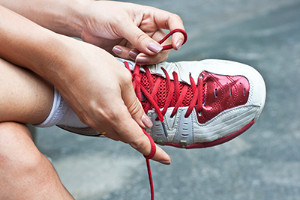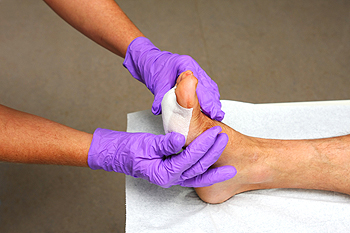Connect With Us
Blog
Items filtered by date: February 2023
Stages of Blisters

There are many different ways to classify blisters on the feet. For example, sometimes foot blisters are classified by whether they are associated with another condition of the foot or whether they are linked to friction. However, another way to classify blisters on the feet is by assessing the state of the blister’s “roof,” or covering. Specifically, if the roof over the blister is fully covering the blister, then this blister is said to be “roof intact.” However, if the roof becomes slightly torn, then the blister is said to be “roof torn.” At this stage of the blister, infection is a possibility due to the torn roof. Lastly, if the roof has completely fallen off or been ripped off, then this is known as a “deroofed” blister. If you are someone that is prone to developing blisters on the feet, it is suggested that you schedule an appointment with a podiatrist.
Blisters are prone to making everyday activities extremely uncomfortable. If your feet are hurting, contact Jeffrey L. Bober, DPM of Maryland. Our doctor can provide the care you need to keep you pain-free and on your feet.
Foot Blisters
Foot blisters develop as a result of constantly wearing tight or ill-fitting footwear. This happens due to the constant rubbing from the shoe, which can often lead to pain.
What Are Foot Blisters?
A foot blister is a small fluid-filled pocket that forms on the upper-most layer of the skin. Blisters are filled with clear fluid and can lead to blood drainage or pus if the area becomes infected.
How Do Blisters Form?
Blisters on the feet are often the result of constant friction of skin and material, usually by shoe rubbing. Walking in sandals, boots, or shoes that don’t fit properly for long periods of time can result in a blister. Having consistent foot moisture and humidity can easily lead to blister formation.
Prevention & Treatment
It is important to properly care for the affected area in order to prevent infection and ease the pain. Do not lance the blister and use a Band-Aid to provide pain relief. Also, be sure to keep your feet dry and wear proper fitting shoes. If you see blood or pus in a blister, seek assistance from a podiatrist.
If you have any questions, please feel free to contact our office located in Glen Burnie, MD . We offer the newest diagnostic and treatment technologies for all your foot care needs.
Foot Arch Types and Gait

There are several different types of running shoes, and it can help to determine what type of running will be done before they are purchased. There are two important things to look for when considering buying running shoes. Comfort and stability as the foot lies in and moves through the shoe is one thing, and having adequate shock absorption is another. Additionally, it is beneficial the shoes can provide enough flexibility while having the proper amount of support, which can ultimately improve running performance. Experienced runners know the importance of determining what type of foot arch they have, in addition to knowing what their gait, or walking style is. The arches are categorized into three types, consisting of normal, high and low. Having a gait assessment is helpful in choosing the right type of running shoes, which can include motion control, stability, or neutral cushioning. If you would like more information about how to choose the right running shoe, please consult with a podiatrist.
If you are a runner, wearing the right running shoe is essential. For more information, contact Jeffrey L. Bober, DPM from Maryland. Our doctor can provide the care you need to keep you pain-free and on your feet.
Choosing the Right Running Shoe for Your Foot Type
To increase performance and avoid the risk of injury, it is important to choose the right running shoe based on your foot type. The general design of running shoes revolves around pronation, which is how the ankle rolls from outside to inside when the foot strikes the ground.
- Neutral runners are able to choose from a wide variety of shoes, including minimalist shoes or even going barefoot.
- Runners who overpronate, or experience an over-abundance of ankle rolling, should choose shoes that provide extra motion control and stability.
- Runners who underpronate, or supinate, have feet that have high arches and lack flexibility, preventing shock absorption. They require shoes with more flexibility and cushion.
If you have any questions please feel free to contact our office located in Glen Burnie, MD . We offer the newest diagnostic and treatment technologies for all your foot and ankle needs.
How to Treat a Foot Wound

Diabetic patients who develop foot wounds often understand the necessity of properly treating them. This begins with examining the bottom of the feet with a mirror to check for existing cuts. This is helpful in noticing small cuts and scrapes, and prompt treatment may prevent painful infections from developing. Common symptoms of an infected wound can include redness, swelling, and there may be pus that drains. Having a high temperature may accompany an infected wound, in addition to feeling unwell. A foot wound can be treated by cleaning it with warm water, followed by covering it with a protective dressing. It is beneficial that the bandage is changed daily, and walking is limited. If you have a foot wound that has become infected, it is strongly urged that you are under the care of a podiatrist who can effectively treat wounds on the feet.
Wound care is an important part in dealing with diabetes. If you have diabetes and a foot wound or would like more information about wound care for diabetics, consult with Jeffrey L. Bober, DPM from Maryland. Our doctor will assess your condition and provide you with quality foot and ankle treatment.
What Is Wound Care?
Wound care is the practice of taking proper care of a wound. This can range from the smallest to the largest of wounds. While everyone can benefit from proper wound care, it is much more important for diabetics. Diabetics often suffer from poor blood circulation which causes wounds to heal much slower than they would in a non-diabetic.
What Is the Importance of Wound Care?
While it may not seem apparent with small ulcers on the foot, for diabetics, any size ulcer can become infected. Diabetics often also suffer from neuropathy, or nerve loss. This means they might not even feel when they have an ulcer on their foot. If the wound becomes severely infected, amputation may be necessary. Therefore, it is of the upmost importance to properly care for any and all foot wounds.
How to Care for Wounds
The best way to care for foot wounds is to prevent them. For diabetics, this means daily inspections of the feet for any signs of abnormalities or ulcers. It is also recommended to see a podiatrist several times a year for a foot inspection. If you do have an ulcer, run the wound under water to clear dirt from the wound; then apply antibiotic ointment to the wound and cover with a bandage. Bandages should be changed daily and keeping pressure off the wound is smart. It is advised to see a podiatrist, who can keep an eye on it.
If you have any questions, please feel free to contact our office located in Glen Burnie, MD . We offer the newest diagnostic and treatment technologies for all your foot care needs.
Determining the Cause of Toe Pain

Toe pain can have many causes, including trauma, bunions, corns, fractures, and gout. Other causes of toe pain include ingrown toenails, hammertoe, arthritis, and improper footwear. Still other causes of toe pain are athlete’s foot, arthritis, and turf toe. Among the symptoms you may experience are a burning feeling or warmth in the joint, difficulty moving the toe, bruising or skin discoloration, and swelling. To find out the exact cause of the pain, a podiatrist can start by taking a history, such as the location of the pain, when it started, the severity of the pain, and the type of pain. Is it a dull, throbbing sensation or an acute, sharp pain? Is the pain constant or does it come and go? Next a visual examination is likely. If a toe is severely bruised, it may indicate that an X-ray or other imaging test is needed to determine the cause. In some cases, as with diabetic patients, runners, or athletes, a more in-depth history and examination may be necessary. Once the cause is determined, a podiatrist can suggest the proper treatment plan for you.
Toe pain can disrupt your daily activities. If you have any concerns, contact Jeffrey L. Bober, DPM of Maryland. Our doctor can provide the care you need to keep you pain-free and on your feet.
What Causes Toe Pain?
Most severe toe pain is caused due to a sports injury, trauma from dropping something heavy on the toe, or bumping into something rigid. Other problems can develop over time for various reasons.
Toe pain can be caused by one or more ailments. The most common include:
- Trauma
- Sports injury
- Wearing shoes that are too tight
- Arthritis
- Gout
- Corns and calluses
- Hammertoe
- Bunions
- Blisters
- Ingrown toenails
- Sprains
- Fractures (broken bones)
- Dislocations
When to See a Podiatrist
- Severe pain
- Persistent pain that lasts more than a week
- Signs of infection
- Continued swelling
- Pain that prevents walking
Diagnosis
In many cases the cause of toe pain is obvious, but in others, a podiatrist may want to use more advanced methods to determine the problem. These can range from simple visual inspections and sensation tests to X-rays and MRI scans. Prior medical history, family medical history, and any recent physical traumatic events will all be taken into consideration for a proper diagnosis.
Treatment
Treatments for toe pain and injuries vary and may include shoe inserts, padding, taping, medicines, injections, and in some cases, surgery. If you believe that you have broken a toe, please see a podiatrist as soon as possible.
If you have any questions please feel free to contact our office located in Glen Burnie, MD . We offer the newest diagnostic tools and technology to treat your foot and ankle needs.
Wounds That Don't Heal Need to Be Checked
Blog Archives
- April 2025
- March 2025
- February 2025
- January 2025
- December 2024
- November 2024
- October 2024
- September 2024
- August 2024
- July 2024
- June 2024
- May 2024
- April 2024
- March 2024
- February 2024
- January 2024
- December 2023
- November 2023
- October 2023
- September 2023
- August 2023
- July 2023
- June 2023
- May 2023
- April 2023
- March 2023
- February 2023
- January 2023
- December 2022
- November 2022
- October 2022
- September 2022
- August 2022
- July 2022
- June 2022
- May 2022
- April 2022
- March 2022
- February 2022
- January 2022
- December 2021
- November 2021
- October 2021
- September 2021

